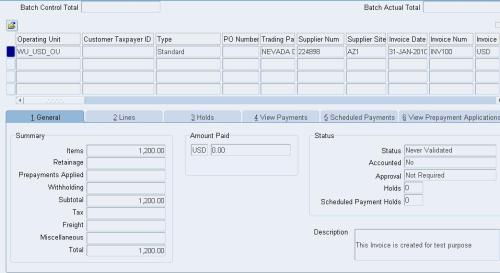The attachments feature in oracle application enables users to link unstructured data, such as images, word-processing documents, spreadsheets, or text to their application data. For example, users can link images to items or video to operations as operation instructions.
Where to find an attachment?
There is an attachment icon in the oracle application toolbar that indicates whether the Attachments feature is enabled in a form block. When the button is dimmed, the Attachment feature is not available. When the Attachment feature is enabled in a form block, the icon becomes a solid paper clip. The icon switches to a paper clip holding a paper when the Attachment feature is enabled in a form lock and the current record has at least one attachment.
Attachment types:
An attached document can be:
1] Short Text
Text stored in the database containing less than 2000 characters.
2] Long Text
Text stored in the database containing 2000 characters or more.
3] Image
An image that Oracle Forms can display, including: bmp, cals, jfif, jpeg, gif, pcd, pcx, pict, ras, and tif.
4] OLE Object
An OLE Object that requires other OLE server applications to view, such as Microsoft Word or Microsoft Excel.
5] Web Page
A URL reference to a web page which you can view with your web browser.
Tables Involved:
For Importing Attachments in oracle application one has to populate following tables.
1. FND_DOCUMENTS
2. FND_ATTACHED_DOCUMENTS
3. FND_DOCUMENTS_TL
4. FND_DOCUMENT_DATATYPES.
5. FND_DOCUMENT_CATEGORIES
6. FND_DOCUMENTS_LONG_TEXT (Long text type attachment).
7. FND_DOCUMENTS_SHORT_TEXT (Short text type attachment).
8. FND_DOCUMENTS_LONG_RAW
9. FND_LOBS (File type attachments).
FND_DOCUMENTS:
FND_DOCUMENTS stores language-independent information about a document. For example, each row contains a document identifier, a category identifier, the method of security used for the document (SECURITY_TYPE, where 1=Organization,2=Set of Books, 3=Business unit,4=None), the period in which the document is active, and a flag to indicate whether or not the document can be shared outside of the security type (PUBLISH_FLAG).
Other specifications in this table include: datatype (DATATYPE_ID, where 1=short text,2=long text, 3=image, 4=OLE object), image type, and storage type (STORAGE_TYPE, where 1=stored in the database, 2=stored in the file system).
The document can be referenced by many application entities and changed only in the define document form (USAGE_TYPE=S); it can be used as a fill-in-the-blanks document, where each time you use a template, you make a copy of it (USAGE_TYPE=T); or it can be used only one time (USAGE_TYPE=O).Images and OLE Objects cannot be used as templates.
FND_ATTACHED_DOCUMENTS:
FND_ATTACHED_DOCUMENTS stores information relating a document to an application entity. For example, a record may link a document to a sales order or an item. Each row contains foreign keys to FND_DOCUMENTS and FND_DOCUMENT_ENTITIES. There is also a flag to indicate whether or not an attachment was created automatically.
FND_DOCUMENTS_TL:
FND_DOCUMENTS_TL stores translated information about the documents in FND_DOCUMENTS. Each row includes the document identifier, the language the row is translated to, the description of the document, the file in which the image is stored, and an identifier (MEDIA_ID) of the sub-table in which the document is saved (FND_DOCUMENTS_SHORT_TEXT, FND_DOCUMENTS_LONG_TEXT, or FND_DOCUMENTS_LONG_RAW).
FND_DOCUMENT_DATATYPES:
FND_DOCUMENT_DATATYPES stores the document datatypes that are supported. Initial values are: short text, long text, image, and OLE Object (DATATYPE_ID=1, 2, 3, or 4). Customers can add datatypes to handle documents stored outside of Oracle and use non-native Forms applications to view/edit their documents. The table uses a “duplicate record” model for handling multi-lingual needs. That is, for each category there will be one record with the same CATEGORY_ID and CATEGORY_NAME for each language.
FND_DOCUMENT_CATEGORIES:
FND_DOCUMENT_CATEGORIES stores information about the categories in which documents are classified. For example, documents may be considered “Bill of Material Comments”, “WIP Job Comments”, etc. Document categories are used to provide a measure of security on documents. Each form that enables the attachment feature lists which categories of documents can be viewed in the form. This table uses a “duplicate record” model for handling multi-lingual needs.
FND_DOCUMENTS_LONG_TEXT:
FND_DOCUMENTS_LONG_TEXT stores information about long text documents.
FND_DOCUMENTS_SHORT_TEXT:
FND_DOCUMENTS_SHORT_TEXT stores information about short text documents.
FND_DOCUMENTS_LONG_RAW:
FND_DOCUMENTS_LONG_RAW stores images and OLE Objects, such as Word Documents and Excel spreadsheets, in the database.
FND_DOCUMENT_ENTITIES:
FND_DOCUMENT_ENTITIES lists each entity to which attachments can be linked. For example, attachments can be linked to Items, Sales Orders, etc. Since the table uses a “duplicate record” model for handling multi-lingual needs, for each document entity there will be one record with the same DOCUMENT_ENTITY_ID and DATA_OBJECT_CODE for each language.
Queries:
1] To find all Long Text attachments:
SELECT
FAD.SEQ_NUM “Seq Number”,
FDAT.USER_NAME “Data Type”,
FDCT.USER_NAME “Category User Name”,
FAD.ATTACHED_DOCUMENT_ID “Attached Document Id”,
FDET.USER_ENTITY_NAME “User Entity”,
FD.DOCUMENT_ID “Document Id”,
FAD.ENTITY_NAME “Entity Name”,
FD.MEDIA_ID “Media Id”,
FD.URL “Url”,
FDT.TITLE “Title”,
FDLT.LONG_TEXT “Attachment Text”
FROM
FND_DOCUMENT_DATATYPES FDAT,
FND_DOCUMENT_ENTITIES_TL FDET,
FND_DOCUMENTS_TL FDT,
FND_DOCUMENTS FD,
FND_DOCUMENT_CATEGORIES_TL FDCT,
FND_ATTACHED_DOCUMENTS FAD,
FND_DOCUMENTS_LONG_TEXT FDLT
WHERE
FD.DOCUMENT_ID = FAD.DOCUMENT_ID
AND FDT.DOCUMENT_ID = FD.DOCUMENT_ID
AND FDCT.CATEGORY_ID = FD.CATEGORY_ID
AND FD.DATATYPE_ID = FDAT.DATATYPE_ID
AND FAD.ENTITY_NAME = FDET.DATA_OBJECT_CODE
AND FDLT.MEDIA_ID = FD.MEDIA_ID
AND FDAT.NAME = ‘LONG_TEXT’;
2] To find all Short Text attachments:
SELECT
FAD.SEQ_NUM “Seq Number”,
FDAT.USER_NAME “Data Type”,
FDCT.USER_NAME “Category User Name”,
FAD.ATTACHED_DOCUMENT_ID “Attached Document Id”,
FDET.USER_ENTITY_NAME “User Entity”,
FD.DOCUMENT_ID “Document Id”,
FAD.ENTITY_NAME “Entity Name”,
FD.MEDIA_ID “Media Id”,
FD.URL “Url”,
FDT.TITLE “Title”,
FDST.SHORT_TEXT “Attachment Text”
FROM
FND_DOCUMENT_DATATYPES FDAT,
FND_DOCUMENT_ENTITIES_TL FDET,
FND_DOCUMENTS_TL FDT,
FND_DOCUMENTS FD,
FND_DOCUMENT_CATEGORIES_TL FDCT,
FND_ATTACHED_DOCUMENTS FAD,
FND_DOCUMENTS_SHORT_TEXT FDST
WHERE
FD.DOCUMENT_ID = FAD.DOCUMENT_ID
AND FDT.DOCUMENT_ID = FD.DOCUMENT_ID
AND FDCT.CATEGORY_ID = FD.CATEGORY_ID
AND FD.DATATYPE_ID = FDAT.DATATYPE_ID
AND FAD.ENTITY_NAME = FDET.DATA_OBJECT_CODE
AND FDST.MEDIA_ID = FD.MEDIA_ID
AND FDAT.NAME = ‘SHORT_TEXT’;
Attachment upload through API:
Attachments can also be uploaded through an oracle provided API called FND_ATTACHED_DOCUMENTS_PKG.
It consist of three procedures
1) Insert Row
2) Update Row
3) Lock Row
Names of these procedures are self explanatory. insert row is used to insert a new row for attachment data, update row is used to update existing row for a particular row and Lock Row is used to lock a existing row for further modification.





Recent Comments